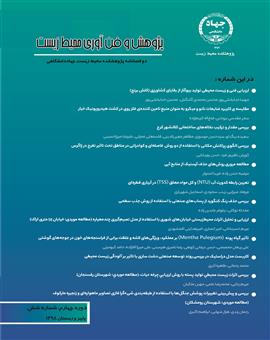-
-
List of Articles
-
Open Access Article
1 - Environmental and Technical Assessment of Biogas Production using Rice Straw
Mahsa Khodabakhshi pour mohsenq mohammadi mohsen khodabakhshipour -
Open Access Article
2 - Compare of the Application of Nano and Micro Wastes as Supplying Source of Zinc in Cucumber Hydroponic Culture
sahar moghaddasi fathallah karimzadeh -
Open Access Article
3 - Study of the Amount and Composition of Construction and Demolition Wastes in the Karaj City
Saeideh Bigdeloo Seyed Hassan Mousavi Mazaher Moeinaddini ghasemali omrani -
Open Access Article
4 - Studying the Spatial Distribution Pattern using Distance and Quadratic Methods in the Zagros Recreational Areas
koroush nazarpoorfard Hassan pourbabaei -
Open Access Article
5 - A Review of Arsenic Removal Methods from Water Resources
Marzieh Hasanzadeh Fariba Ostovar -
Open Access Article
6 - Determination of the Relationship between Water Turbidity (NTU) and Total Suspended solids (TSS) in drip irrigation
farhad mirzaei zeynab sojoodi -
Open Access Article
7 - Investigation of Congored dye removal from industrial waste water using adsorption method
Mohadeseh Tavakoli niloofar Abedinzade -
Open Access Article
8 - Assessment and Environmental Impact Analysis of the Urban Streets using Multi-Criteria Decision Making Model (Case Study: 58-meter street of Arak)
maryam hosseinkhani amir ansari amir Hedayati Agmashhadi -
Open Access Article
9 - Effect of Pennyroyal (Mentha Pulegium L.) on Performance, Carcass Characteristics and Some of the Blood Parameters in Broilers
Ali Reyan Mohasesi Hasan Darmani Koohi Reza Naseri Harsini Ali Mirza Aghazadeh Hamed Kioumarsi -
Open Access Article
10 - Application of Drastic Model in the Studying Process of Industrial Development of Sari Plain
Mohammad rahmani tahere azari -
Open Access Article
11 - The Study of Environmental Impacts of Pistachio Production Using Life Cycle Assessment, (Case Study: Rafsanjan City)
Maryam Rajaei Mohammad Reza Elmi Mahin Malekian -
Open Access Article
12 - Investigation and prediction on Forests Covers Changes Using Fuzzy Object-Based Satellite Image Classification and CA-Markov (case study: City of Romeshkan)
Rahman Zandi Hajar Shehabi Ebrahim Akbari
-
The rights to this website are owned by the Raimag Press Management System.
Copyright © 2017-2025







